Today’s picture shows the sun setting over Big Bear Lake. (Note that the foreground is not a dry lake bed. The lake itself is off in the distance.) This photo is part of a quasi-diptych, and I will put up the second part tomorrow.


Today’s picture shows the sun setting over Big Bear Lake. (Note that the foreground is not a dry lake bed. The lake itself is off in the distance.) This photo is part of a quasi-diptych, and I will put up the second part tomorrow.

You may not have noticed this when it happened, but North Carolina elected a Democratic governor in 2016. It was a close race, and Republicans demanded multiple recounts, but eventually they conceded and Roy Cooper was declared the winner.
But that didn’t mean everything was over. After all, there was another month left in which lame duck Republican Pat McRory was still governor and the Republican legislature was still running things. So they did something unique: they passed a series of bills that stripped the governor of some of his powers. Cooper sued after he took office, of course, and the whole mess is currently working its way through the courts. Still, as corrupt as this was, at least it was just North Carolina, which has a recent history of anti-democratic actions barely matched since the end of Reconstruction.
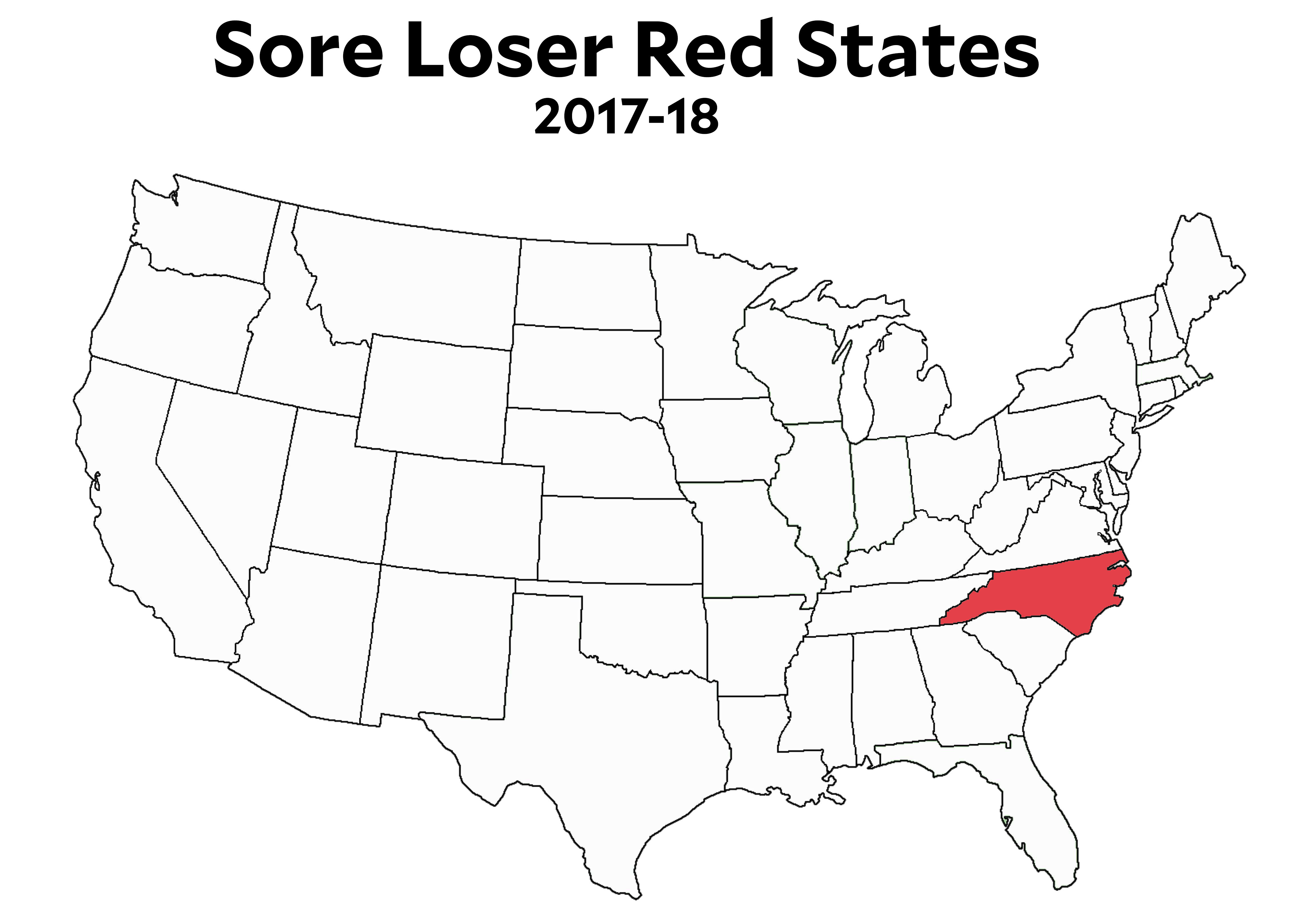
You’ll be unsurprised to learn that this wasn’t the end of the story. In the same way that voter ID bills spread throughout red states after the first one produced light bulbs all over GOP-land, the same thing is happening here. Republicans who lost reelection bids in November are casting their eyes toward North Carolina and thinking that those Tarheels had a pretty good idea. Here’s Michigan:
With Democrats set to take over top statewide offices next year, Michigan Republicans are considering proposals that would allow the Legislature to intervene in legal battles and shift oversight of the state’s campaign finance law to a new commission. The lame-duck power plays would limit the power of Gov.-elect Gretchen Whitmer, Attorney General Dana Nessel and Secretary of State Jocelyn Benson. Democrats have not held all three posts since 1990.
A House bill introduced Thursday by state Rep. Rob VerHeulen, R-Walker, and quickly praised by Republican leaders seeks to guarantee the GOP-led Legislature could intervene in legal battles involving state laws that Democrats may be hesitant to defend. A separate proposal from Sen. Dave Robertson, R-Grand Blanc, would shift oversight of the Michigan Campaign Finance Act from the Secretary of State’s Office to a newly proposed “fair political practices commission.”
The incoming Democrats had promised a crackdown on dark money contributions, and this is an obvious attempt to stop them. The new commission would be split evenly between Republicans and Democrats, which would halt campaign finance reform in its tracks. And if Michigan can do it, you know that Scott Walker must be looking on from Wisconsin wondering if he can do the same thing. Our own Samantha Michaels has that story:
Republican lawmakers in Wisconsin are making a last-ditch effort to strip crucial powers from the incoming Democratic governor and attorney general before Republican Gov. Scott Walker finishes his term, in a move that could have sweeping implications for health insurance and voting rights in one of the country’s most important swing states. In a special session on Monday, the Republican-held Legislature will consider a bill that would … take away his ability to approve major decisions by Attorney General-elect Josh Kaul … granting this power to Republican lawmakers instead.
The 141-page bill was unveiled Friday, and lawmakers are expected to vote on it Tuesday.
And so the red splotch expands, as Republicans desperately try to thwart democracy and the usual peaceful transfer of power. Will our courts let them get away with this? Stay tuned.
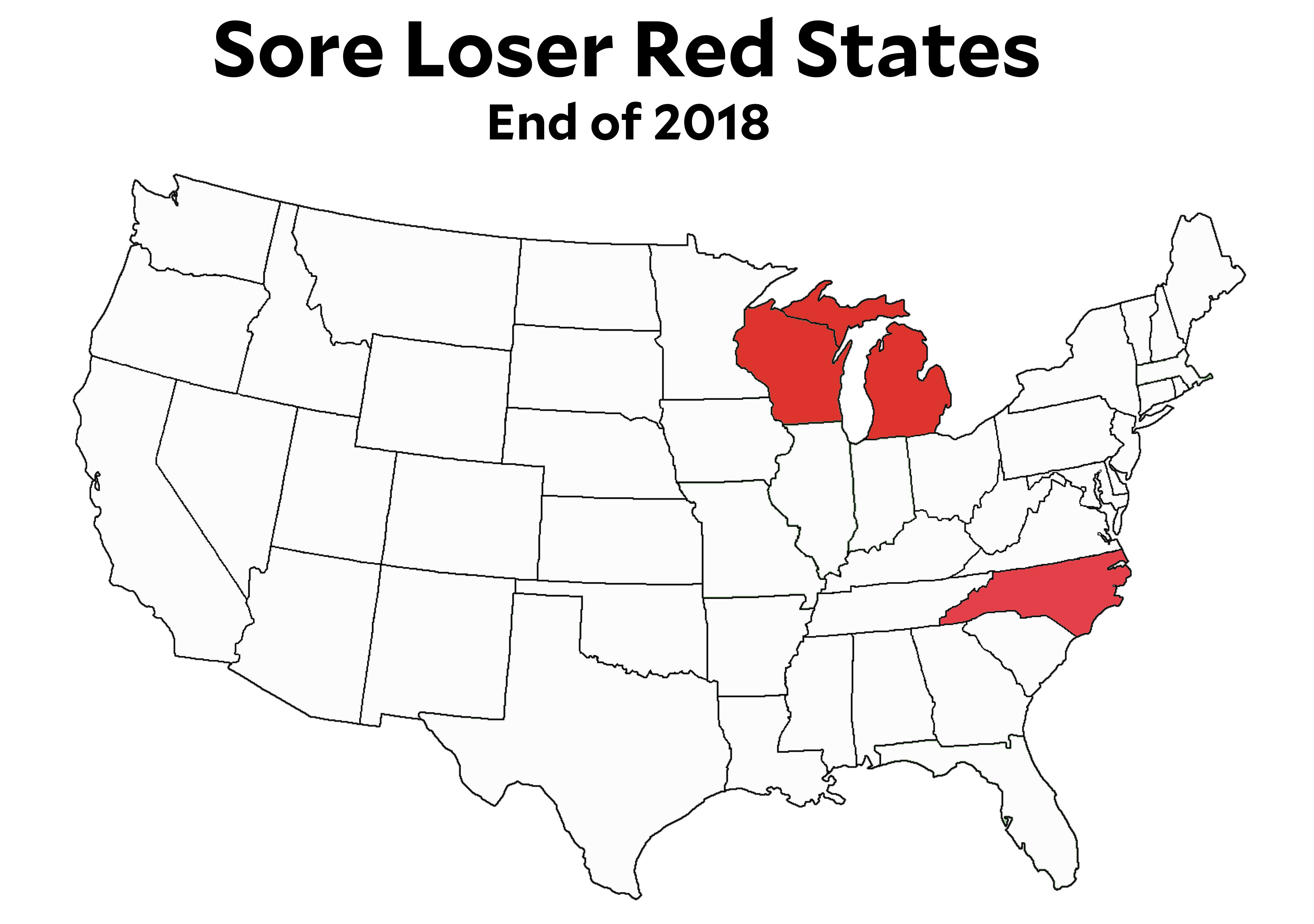
UPDATE: Yes, I seem to have regressed to the point where I can no longer distinguish between Virginia and North Carolina on a map. Sorry, Virginians! The maps have been corrected.
Generally speaking, the yield on a 5-year treasury bond should be higher than it is on 3-year bond. After all, the longer term means you’re taking on a little more risk. Today, however, after years of breathless waiting, this is no longer true. The yield curve has “inverted,” and as I type this both 3- and 5-year bonds are yielding 2.84 percent.
The conventional wisdom says that this is because investors are betting on the Fed reducing interest rates in the near future. With lower rates around the corner, investors want to lock in the higher rates currently available for as long as they can, so they’re snapping up 5-year treasurys, which in turn has reduced their yield below the 3-year rate.
That all makes sense, but why do investors think the Fed will shortly be reducing interesting rates? Because a recession is coming.
That’s the conventional wisdom, anyway. You may decide for yourself whether to believe it.
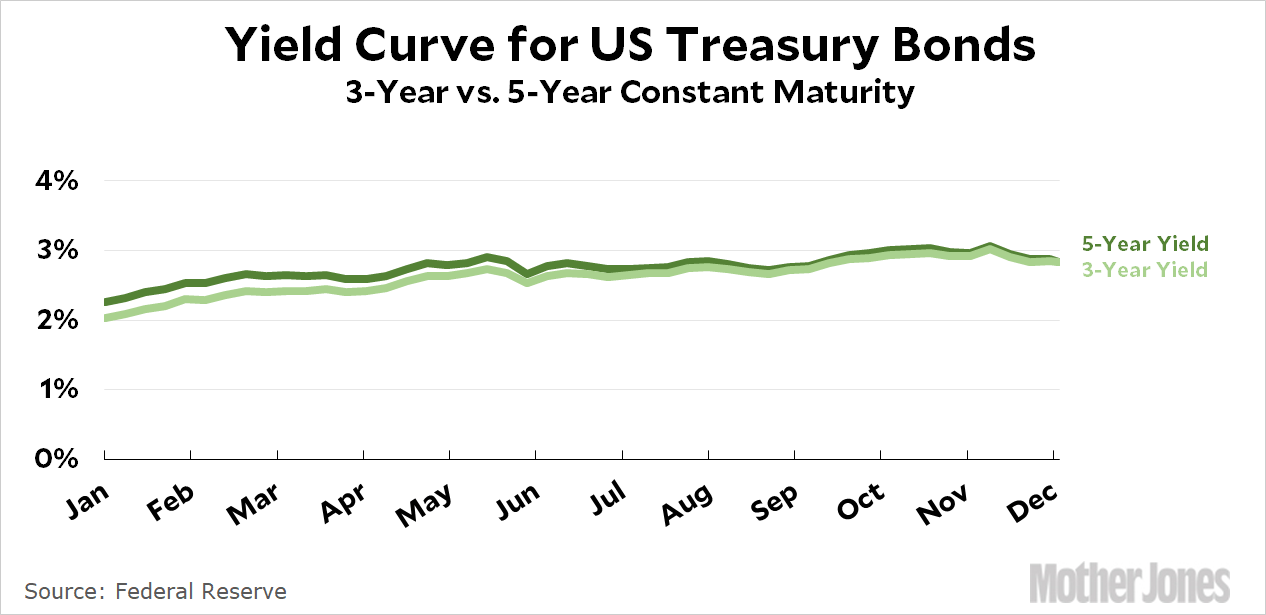

The LA Times tells us the story of a California woman who decided to go without insurance this year:
Without an Obamacare penalty, many are planning to drop health plans. The consequences could be dire
Dana Farrell’s car insurance is due. So is her homeowner’s insurance — plus her property taxes. It’s also time to re-up her health coverage. But that’s where Farrell, a 54-year-old former social worker, is drawing the line.
“I’ve been retired two years and my savings is gone. I’m at my wit’s end,” said the Murrieta resident. So Farrell plans — reluctantly — to drop her health coverage next year because the Affordable Care Act tax penalty for not having insurance is going away.
….Farrell is among millions of people likely to dump their health insurance because of a provision in last year’s Republican tax bill that repeals the Obamacare tax penalty, starting in 2019, by zeroing out the fines….Some people who from the start hated the Affordable Care Act, or Obamacare as it is often called, will drop their coverage as a political statement. For people such as Farrell, it’s simply an issue of affordability.
Since Farrell started buying her own insurance through the open market in 2016, her monthly premium has swelled by about $200, she says, and she bears the entire cost of her premium because she doesn’t qualify for federal ACA tax credits. Next year, she says, her premium would have jumped to about $600 a month.
Obamacare’s individual mandate forced everyone to buy insurance. If you didn’t, you had to pay a fine of about $800. Republicans reduced the fine to zero, which means—presumably—that lots of people who were buying insurance solely to avoid the fine will probably skip it this year.
But how many? The Congressional Budget Office predicted 4 million people would drop insurance. Based on enrollment figures so far, that’s obviously way too high. Obamacare enrollment this year looks like it will end up maybe a million less than 2018, and that’s not all due to the mandate going away. Some of it because of the improving economy and some of it is for miscellaneous other reasons. Still, the end of the mandate is clearly having an effect.
But this particular story also includes one of the usual mysteries of Obamacare reporting. Dana Farrell says she’s retired and her savings are gone. She’s at her “wit’s end.” And yet, she doesn’t qualify for Obamacare subsidies. What’s up with that? You can qualify for subsidies with an income up to about $50,000. The story doesn’t say, but presumably this means she’s a victim of the Obamacare subsidy cliff: she has a pension of around $60,000 or so, which is just above the subsidy cutoff, and therefore has to pay the full freight on a premium of $7,000 per year. That’s a big chunk of money.
And it’s almost certainly why she’s foregoing insurance. The Obamacare penalty of $800 had nothing to do with it. I’m willing to bet both my cats that this is a story of the subsidy cliff and a savings account that ran dry, not the individual mandate fine.
How are we doing on inflation these days? Should the Fed be worried enough about it to raise interest rates even further?
It sure doesn’t seem like it. Here are two charts. The first one shows core inflation (inflation less food and energy), the preferred measure of the Fed. It’s been hovering around their target rate of 2 percent for more than six years, and both of the major measures of inflation are currently within a few tenths of a point of 2 percent.
The future looks equally placid. Expectations of future inflation have been pretty steady for the past six years, and are currently within a few tenths of a point of 2 percent.
In neither case is there any sense of acceleration, nor even of upward movement. Core inflation itself has been bobbling around 2 percent for years, while inflationary expectations have been declining steadily. If there’s any reason to be fearful of accelerating inflation in the near future, it sure isn’t visible in the numbers themselves.
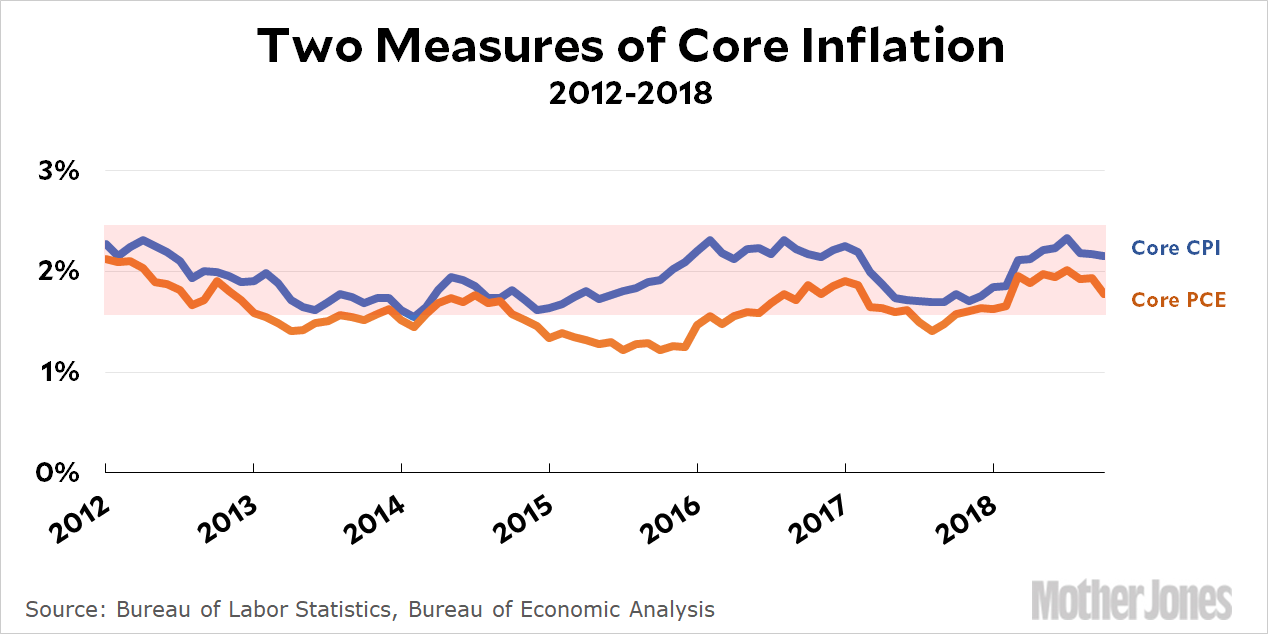
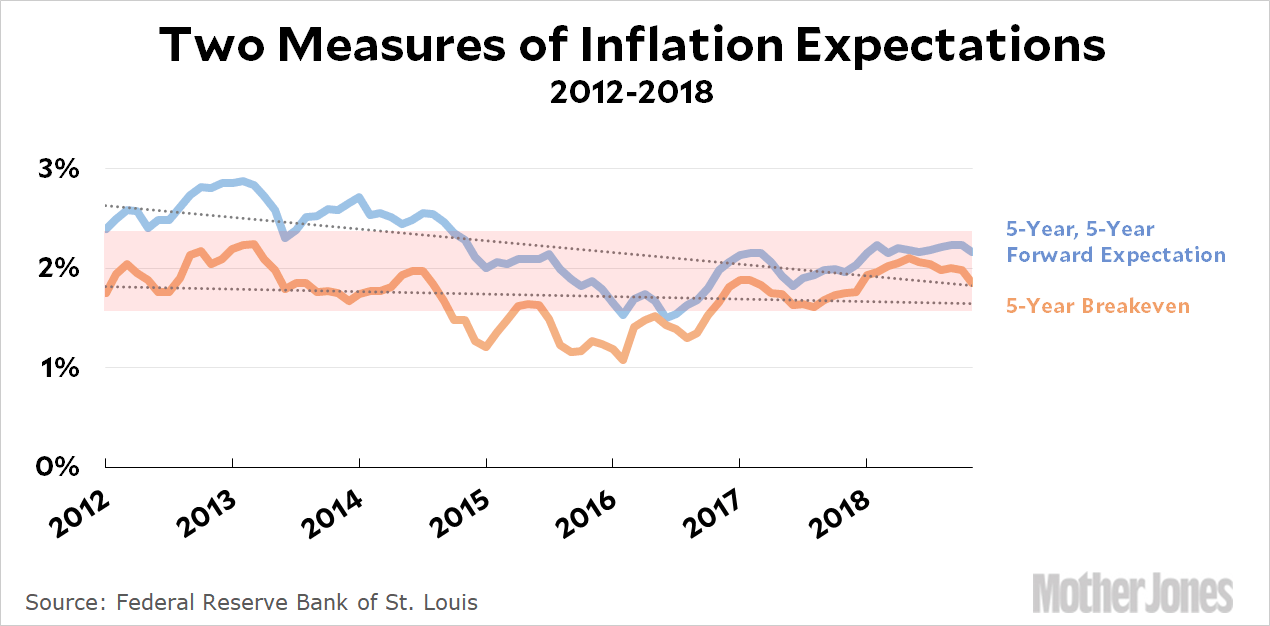
There have been a bunch of food scares this year, culiminating in a warning of E. coli in romaine lettuce announced last week—the second one in 2018. So what’s going on? Is our food getting worse? Jack Denton of Pacific Standard says, not really:
When there’s an increase in outbreaks without a rise in individual illnesses, it means that technology and epidemiologists have gotten better at identifying why people are getting sick—that more illnesses which might have been considered sporadic in past years are now successfully linked to a common source. And the CDC’s latest available charting of foodborne illness rates shows that they are not on the rise in the U.S. Between 2008 and 2015, E. coli infections dropped by 30 percent, and most foodborne illnesses saw no change.
Accordingly, any increase in identified outbreaks is good, likely the result of two major technological changes in roughly the last two decades that have led to scores more outbreaks being successfully identified. In 1996, the CDC began using Pulsenet, a system that tracks foodborne illnesses across the country by comparing the DNA fingerprint of discovered pathogens to see if they are similar….Starting in 2008, the public-health community began using a new method of DNA fingerprinting called whole genome sequencing, which has led to a large spike in detected outbreaks. “I get leery because I don’t think we can compare pre-2008 to today, because we measure things differently,” Chapman says. “We’re getting better at detecting the outbreaks, and there are better-trained public-health individuals now looking to solve foodborne illness outbreaks than we’ve ever had.”
This got me curious, but it turns out the CDC makes it surprisingly difficult to find and summarize annual outbreaks of foodborne illnesses. But not impossible! Assuming I copied the numbers correctly and then did the arithmetic right, here’s the overall incidence of foodborne illnesses in the US since 1996:
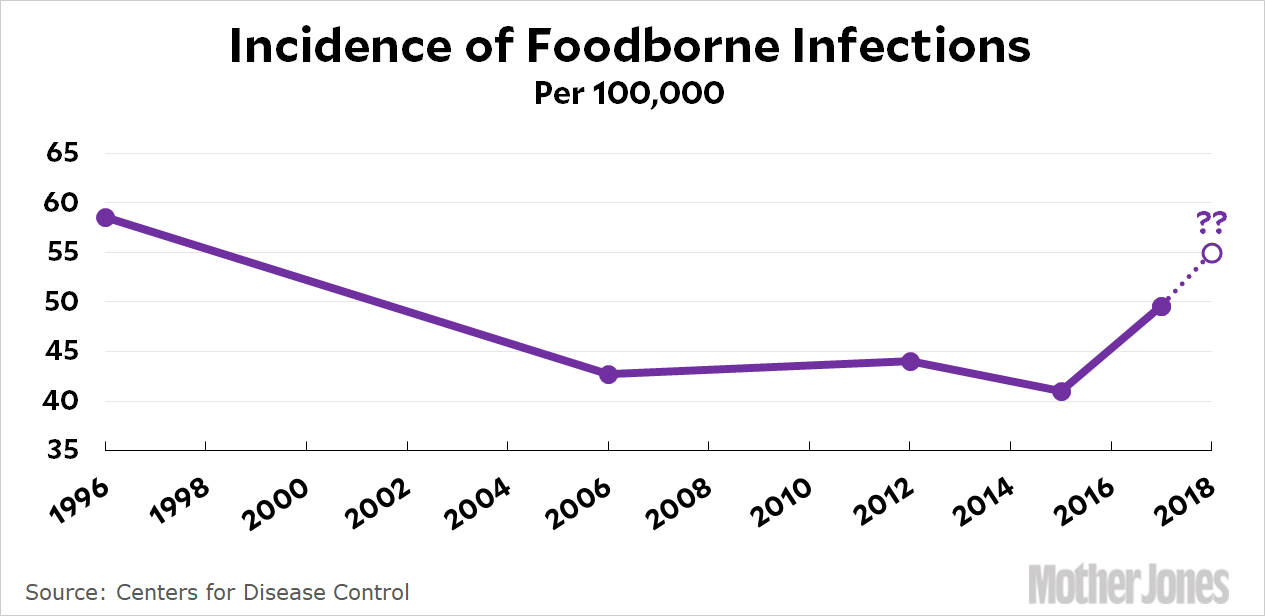
E. coli may be down between 2008 and 2015, but overall foodborne illnesses spiked upward in 2017, and that’s using the same new technology the CDC put in place in 2008. Numbers for 2018 aren’t available yet, so we don’t know if things have gotten even worse since the 2017 spike.
In any case, I’m not really sure why we put up with this. I’ve probably mentioned this before, but a big part of the answer to food poisoning is simple: irradiation. It’s simple, safe, and it’s old technology with years of use behind it. It won’t do anything for foodborne illnesses introduced during prep—Chipotle can’t run your tacos through an irraditation machine on the way to the cash register—but it would be a boon to the packaged food industry. For all practical purposes, if it were made mandatory it would entirely eliminate foodborne illnesses in raw commercial and packaged foods.
But it’s opposed by conservatives because it’s a regulation that would save lives, and who wants that? And to make things worse, it’s also opposed by many liberals, who view it as a Frankenfood sort of thing that would destroy their precious organic labels. In fact, it would do no such thing. It doesn’t leave any radiation behind, it doesn’t kill off vitamins, and it doesn’t affect the taste of food. It just kills off pathogens, the same as pasteurizing milk.
Why, even lefty rags like Mother Jones think it’s a good idea. You can read all about it here.
NOTE: The CDC monitors all reported foodborne infections in a surveillance area that includes ten states. These states are hopefully representative of the whole nation, but you never know. For that reason, the numbers in the chart have a higher uncertainty than usual.
Also, there are far more cases of foodborne infection that are never reported. This includes the 24-hour bugs and so forth that we all get but never bother seeing a doctor about. CDC estimates the total number of foodborne illnesses in the US at about 50 million per year.
Here is Hilbert wandering around on our patio cover. He was in quite the mood, which made it really hard to pick the best picture out of the lot. This means that eventually you’ll probably see a few others—unless he provides me with lots of better ones before I get around to it. He usually does.

Last year, Eva Vivalt of the Australian National University wrote a paper analyzing the results of international development programs like microloans, deworming, cash transfers, and so forth. This chart shows the basic results:
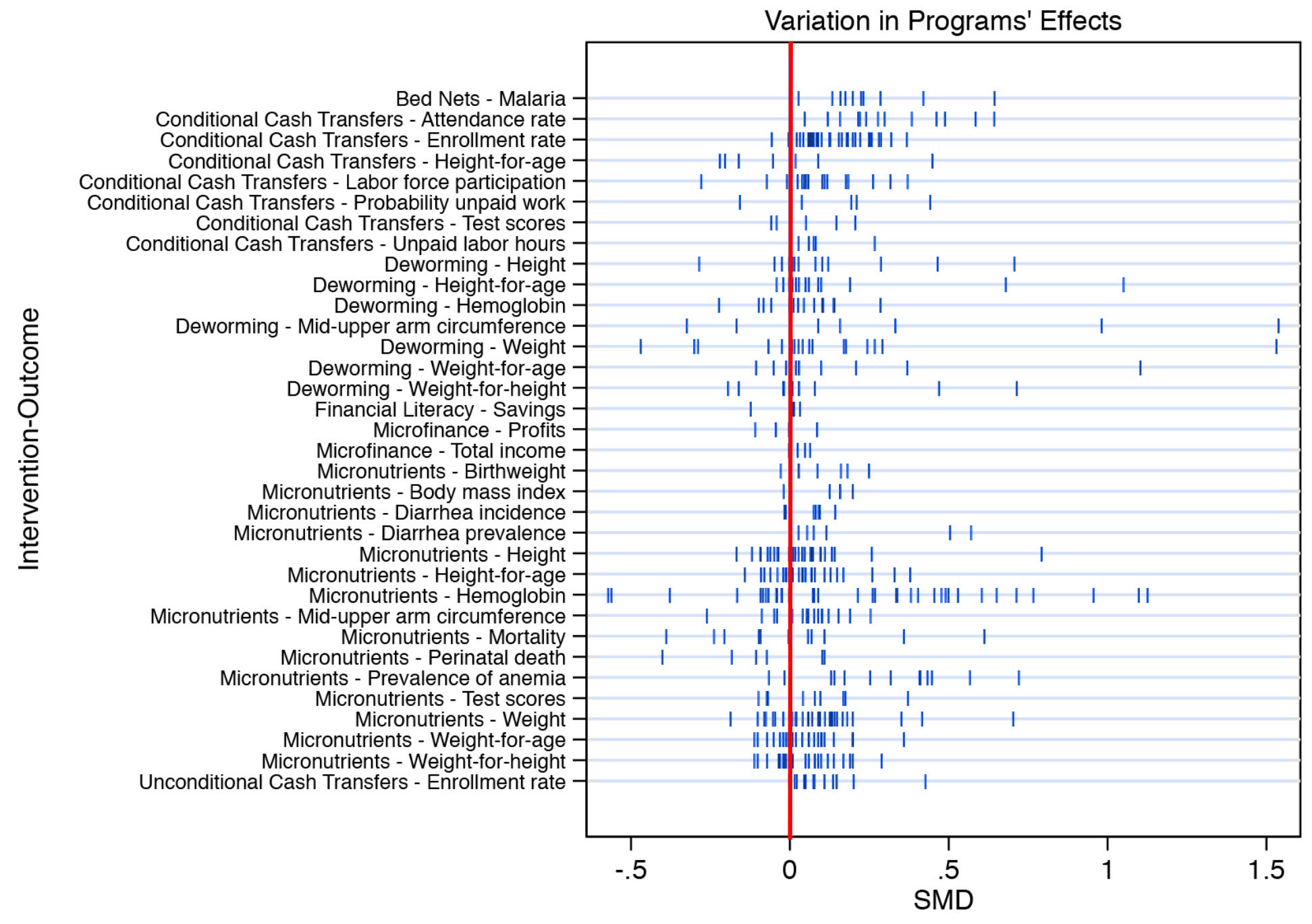
There are two things to notice. First, there’s not a lot of clustering. For nearly all these programs, the results are pretty widely dispersed. Second, where there is clustering, it’s right around zero, where the results are the least meaningful. A few months after Vivalt published her paper, Robert Wiblin described it this way:
The typical study result differs from the average effect found in similar studies so far by almost 100%. That is to say, if all existing studies of an education program find that it improves test scores by 0.5 standard deviations — the next result is as likely to be negative or greater than 1 standard deviation, as it is to be between 0-1 standard deviations….She also observed that results from smaller studies conducted by NGOs — often pilot studies — would often look promising. But when governments tried to implement scaled-up versions of those programs, their performance would drop considerably.
Last week, a charity announced a dramatic specific confirmation of Vivalt’s general results. Kelsey Piper provides the details:
No Lean Season is an innovative program that was created to help poor families in rural Bangladesh during the period between planting and harvesting (typically September to November). During that period, there are no jobs and no income, and families go hungry….No Lean Season aimed to solve that by giving small subsidies to workers so they could migrate to urban areas, where there are job opportunities, for the months before the harvest. In small trials, it worked great.
….Evidence Action wanted more data to assess the program’s effectiveness, so it participated in a rigorous randomized controlled trial (RCT) — the gold standard for effectiveness research for interventions like these — of the program’s benefits at scale. Last week, the results from the study finally came in — and they were disappointing. In a blog post, Evidence Action wrote: “An RCT-at-scale found that the [No Lean Season] program did not have the desired impact on inducing migration, and consequently did not increase income or consumption.” (The emphasis is in the original blog post.)
This admission was a big deal in development circles. Here’s why: It is exceptionally rare for a charity to participate in research, conclude that the research suggests its program as implemented doesn’t work, and publicize those results in a major announcement to donors.
I’m writing about this as much as a warning to myself as a warning to everyone else. In one sense, this is just part of the recent replicability crisis in the social sciences, but it really goes back farther than that. It’s been pretty well known for a very long time that the biggest problem with interventions like these is scalability. Pilot studies have the luxury of being (relatively) easy to fund since they’re small; being able to choose sites where everyone is excited about the program and buys into it; not having to account for long-term feedback caused by the existence of the program itself (i.e., people get accustomed to the program as a baseline rather than as an interesting new thing); and generally having to deal with less diversity in their sample population, which makes a simple one-size-fits-all program easier to implement and less likely to have to deal with community pushback.
Needless to say, this wide dispersion of results from small studies makes it really easy to cherry pick them to demonstrate whatever point you feel like making. I try to be tolerably honest in my reporting, but it’s nearly impossible not to fall prey to this from time to time.
There’s not a lot more to say about this except to make a few brief points:
This is not a counsel of despair. The truth is that most social interventions at scale just don’t work all that well. This is hard stuff! Still, small pilot studies are the only means we have to provide direction for further research, and large programs that provide even a modest benefit should be considered worthwhile. In other words, we should probably be more demanding of small studies, but less demanding in our expectations for large programs.

Here’s an interesting tweet:
It’s a testament to the extraordinary success of the “PC” narrative that even generally sensible people are often incredulous, in a kind of “I don’t think you’re lying but I still don’t believe you” kind of way, when you tell them your experience doesn’t fit in that narrative. https://t.co/ZBkfKRRwvg
— David Watkins (@djw172) November 25, 2018
I’ve heard this same thing over and over, and it doesn’t surprise me. It’s an example of the “300 million rule”—which I admit is a bit outdated now, but I made it up back when the US population was pretty close to 300 million. In a nutshell, this rule says that in a big country you can find examples of practically anything, no matter how crazy, on a daily or at least weekly basis. So can you find plenty of examples of university students demanding trigger warnings or safe spaces in the most irritating way possible? Sure, of course you can. Does it seem like there’s a lot of this going on? If you hear about it a dozen or so times a year, of course it does. On a personal basis, anything that happens a dozen times a year seems like a lot. And since most people are functionally innumerate, they simply don’t realize at a gut level that a dozen examples is actually a tiny number when you compare it to the number of university students in America (about 13 million). It’s hardly any wonder that individual professors run across it rarely if at all.
Needless to say, this has become exponentially worse in the era of social media. Incidents that used to be little college molehills, reported in the local media if at all, now routinely get spread via viral mobs on social media and then used as fodder to build cable TV mountains. Also needless to say, the folks who promote this stuff have no incentive to tell us if they’re merely reporting a few examples out of thousands, or if these dozens are all they have.
And this goes for liberals as well as conservatives. If you follow liberal media, you’ll hear weekly examples of racist behavior on college campuses. Is that a lot? See above.
None of this means that stuff like this isn’t widespread. What it means is that anecdotes need to be accompanied by data. Unfortunately, there’s this:
Here’s a quiz for you. Which of these articles about, say, starving children in Africa is likely to get the widest readership?
- A piece that tells the story via description and personal anecdotes.
- A piece that tells the story via facts and numbers.
- A piece that combines the two.
Some of us respond to numbers, while some of us respond to stories about people, so the common-sense answer is option C. That should rope in everyone.
In fact, it turns out that C is the worst possible option. Nobody likes it. The numbers people get tired of all the personal stuff, while the tender-hearted people are put off by all the numbers. It turns out that you have to pick one or the other and just accept that you won’t reach everyone.
This kind of sucks. Sadly, though, my personal experience suggests it’s true: I get really tired of stories full of personal anecdotes. Yes, this guy had it really bad. I get it. Now give me the facts. At the same time, there’s a hoary old journalism truism that you lose 10 percent of your readers for every number you put in a story. God only knows how many readers you lose if you include a chart.
To the extent that spinning this stuff as part of a culture war agenda is deliberate, there’s not much we can do about it. Unfortunately, to the extent that it’s because most people actively dislike data, there’s not a whole lot we can do about it either. I’ve spent years pondering this off and on, and I’ve come up with nada. Anyone else have anything?¹
¹And me being me, I don’t want random speculation. I want data.
This map from the Washington Post made the gleeful rounds of liberal Twitter yesterday:
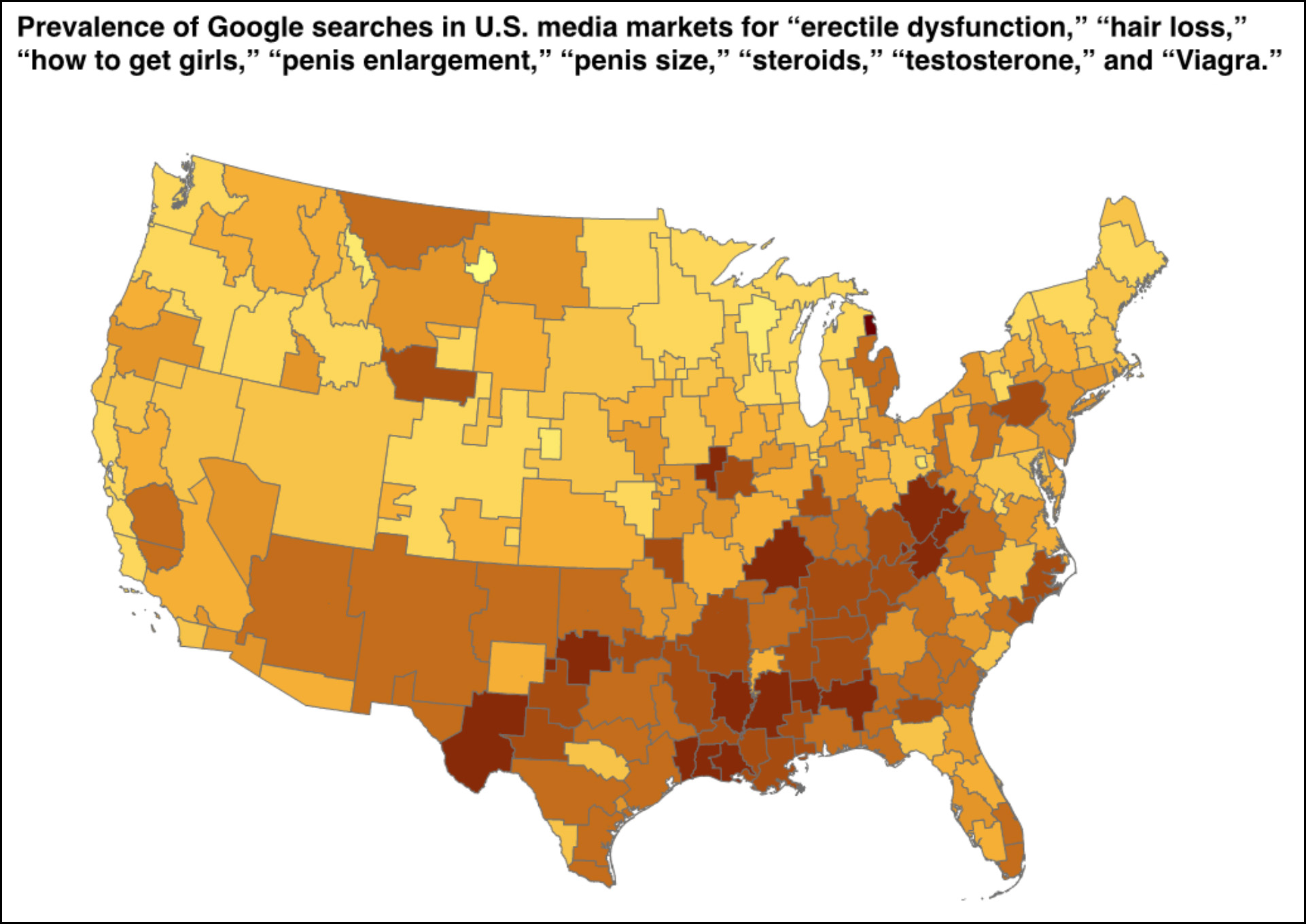
What’s not to like? It shows that all those supposedly manly Southern men aren’t so manly after all. In fact, they’re desperately searching Google for ways to make themselves more manly, and it’s hard for us lefties not to get a chuckle out of that. To make it even better, the accompanying study also showed that all these insecure men voted for Donald Trump in large numbers.
But it seemed sort of dumb to me and I had no plans to write about it: the fact that Southern men voted for Trump in large numbers is hardly news, after all. But then, thanks to the Evil Dex, I had lots of time on my hand and I read the whole piece. It’s written by Eric Knowles and Sarah DiMuccio, who conducted the research:
We found that support for Trump in the 2016 election was higher in areas that had more searches for topics such as “erectile dysfunction.” Moreover, this relationship persisted after accounting for demographic attributes in media markets, such as education levels and racial composition, as well as searches for topics unrelated to fragile masculinity, such as “breast augmentation” and “menopause.”
OK. Not surprising so far. Tell me more.
In contrast, fragile masculinity was not associated with support for Mitt Romney in 2012 or support for John McCain in 2008 — suggesting that the correlation of fragile masculinity and voting in presidential elections was distinctively stronger in 2016.
The same finding emerged in 2018….In the more than 390 House elections pitting a Republican candidate against a Democratic candidate, support for the Republican candidate was higher in districts that, based on Google search data, had higher levels of fragile masculinity. However, there was no significant relationship between fragile masculinity and voting in the 2014 or 2016 congressional elections. This suggests that fragile masculinity has now become a stronger predictor of voting behavior.
Huh. I was uninterested at first because I figured the Trump effect was really just a Republican effect. But no. Insecure men voted in unusually large numbers for the Republican candidate only when that candidate was Trump. And two years later, the effect was still there in a midterm election that was heavily dominated by Trump’s presence.
If this holds up, it suggests that Trump really did appeal to a kind of toxic masculinity in a way that other Republicans haven’t. I suppose that’s not entirely surprising either, but it was just something we all assumed. We’ve not had real evidence of it before.
And it’s interesting in a non-snarky way, too. There’s something about it that’s sort of a mirror image of this whole “deaths of despair” theory, which is mostly driven by rural whites.¹ If it’s true, it’s quite possible that it’s galvanized mostly by factors that affect the self-image of men who have grown up thinking that stereotypical manliness was a core part of who they had to be. Inability to be a good breadwinner would certainly be part of that. Being the “losers” of the feminist movement would be part of it. Being forced to give up their traditional control of family and sex—no more demands, no more casual harassment—would be part of it. A candidate who explicitly appealed to this frustration and promised to fix it—which neither Romney nor McCain did—would attract their votes. Especially if he were running against that shrill harpy Hillary Clinton.
Long story short, this is interesting to the extent that it shows who Trump specifically appealed to above and beyond normal Republican candidates. It’s also something for Democrats to give some serious thought to, even if, like Trump, they currently have few real solutions to offer. I’m not sure what a “real” solution might be, but it’s worth noting that one thing it’s not is an insistence on nominating a man in 2020. Although the authors found that insecure men might like Trump, they held no grudge against women running for office: “Notably, fragile masculinity was unrelated to support for female candidates in the 2018 elections.” That means we can feel free to nominate anyone we want. It just needs to be someone who knows how to talk to insecure men.
¹I’m not entirely sold on the deaths-of-depair theory, but there’s certainly some evidence for it